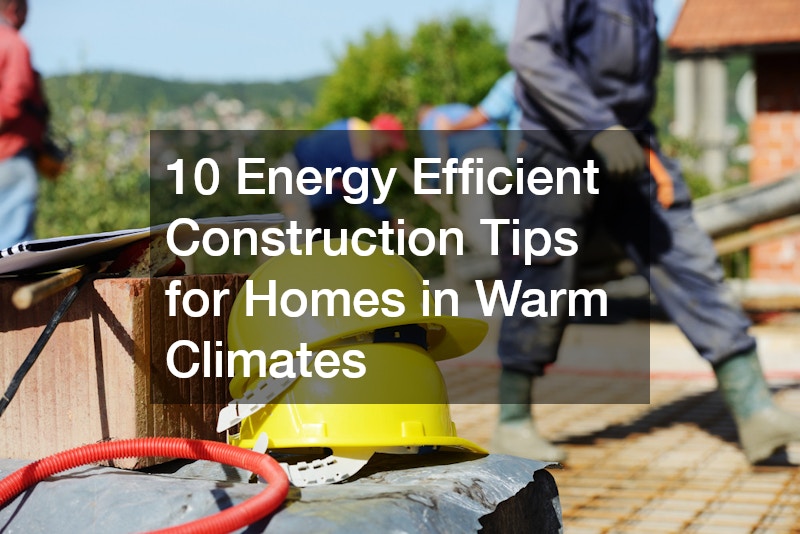
As global temperatures rise, the importance of energy efficient construction cannot be overstated. In warm climates, the integration of energy-efficient techniques not only aids in maintaining comfortable indoor temperatures but significantly reduces energy consumption and utility bills. This article provides ten essential tips for homeowners and builders focusing on fficient construction specifically tailored for warm climates.
Energy efficient construction methods can both enhance the comfort of your home and contribute positively to the environment. By using innovative building materials and techniques, such as improved insulation, reflective roofing, and energy-efficient appliances, homeowners can reduce their carbon footprint while enjoying a cool, comfortable space. Moreover, implementing these strategies often leads to lower energy costs and a more sustainable living environment.
Whether you are building a new home or renovating an existing structure, the tips outlined in this article will guide you towards achieving better energy efficiency. From choosing the right HVAC services to understanding insulation materials, each tip will equip you with the knowledge necessary to make informed decisions. Let’s dive into the details and discover how you can maximize energy efficiency in your construction project.

1. Optimize Orientation and Design
The orientation of your home plays a crucial role in efficient construction. By strategically positioning windows and walls to minimize direct sunlight in living areas, you can significantly reduce heat gain during the day. Additionally, using overhangs and awnings can help keep sunlight from heating your home, while still allowing natural light to fill your space.
Designing a home with open floor plans can promote airflow, which is vital in warm climates. When the design encourages natural ventilation, it helps reduce reliance on air conditioning systems, making it an essential component of energy efficient construction. Furthermore, incorporating thermal mass materials, such as concrete, can absorb heat during the day and release it during cooler night hours.
Always consult with local roofers and architects experienced in energy efficient construction to get the most out of your home’s orientation. They can provide insights on optimal design features that can enhance cooling while reducing energy consumption. This collaborative approach will ensure your home remains comfortable year-round without breaking the bank on energy costs.
2. Choose Energy-Efficient Building Materials
The selection of building materials is critical for energy efficient construction. Opting for materials with good insulation properties, like insulated concrete forms (ICF), can significantly reduce energy loss. Additionally, choosing reflective roofing materials helps deflect harmful UV rays and minimizes heat absorption.
Dense materials like brick or stone can function as thermal mass, holding heat during the day and releasing it when temperatures drop. These materials can significantly contribute to temperature regulation within the home. Also, using energy-efficient windows with low-emissivity (Low-E) coatings can further improve energy performance by reducing heat transfer.
When working with concrete contractors or material suppliers, be sure to inquire about eco-friendly options and energy-efficient building materials. They can guide you in selecting products that not only enhance your home’s efficiency but also support sustainable building practices. Incorporating these materials can make your home not just energy-efficient but also environmentally responsible.

3. Invest in Proper Insulation
Insulation is a cornerstone of efficient construction. In warm climates, effective insulation keeps the heat out and maintains a cooler indoor environment. Selecting the right type of insulation for your home is essential, and varying options like spray foam or reflective insulation can be evaluated based on your specific climate.
Sealing gaps and cracks in your home can help to prevent hot air from entering and cool air from escaping. This will not only enhance comfort but also reduce the workload on your HVAC system. Investing in high-grade insulation material is an upfront cost that leads to significant savings over time in terms of energy bills.
When conducting roof repairs or upgrades, make sure that insulation is included in your project plan. Consulting with an air conditioning contractor for HVAC integration can ensure that your system works efficiently with your insulation choices. The bottom line is that proper insulation is an investment in energy efficient construction that pays off in both comfort and savings.
4. Install Energy-Efficient Windows
Windows have a substantial impact on the energy efficiency of your home. Energy-efficient windows are designed to minimize heat gain while allowing natural light to filter inside. Look for windows rated with the Energy Star label, which ensures a measure of energy efficiency that meets strict guidelines.
The frame material also plays a crucial role in performance; for example, vinyl and fiberglass tend to provide better insulation than aluminum. A sealed window unit will help prevent drafts, and ensuring proper installation is essential for maximizing R-value. In addition, employing local roofers for window installations can provide expertise in ensuring that windows are correctly integrated into your energy efficient construction plan.
Consider the incorporation of window treatments such as shades or reflective films, which can further enhance energy efficiency by controlling solar gain. During hot months, these treatments can reduce the need for air conditioning by maintaining a cooler indoor temperature. Ultimately, investing in high-quality windows is a significant part of creating a sustainable and energy-efficient home.

5. Optimize Your HVAC System
Your home’s HVAC system is integral to energy efficient construction. Ensuring that your heating, ventilation, and air conditioning system operate effectively can drastically reduce energy consumption. Regular maintenance by HVAC services can identify issues early on, preventing costly repairs, and optimizing system performance.
Consider upgrading to a high-efficiency air conditioning unit that is appropriately sized for your home. Oversized systems can cycle on and off too frequently, wasting energy, while undersized systems can struggle to maintain desired temperatures. An experienced air conditioning contractor can assist in selecting the right system that maximizes efficiency.
Additionally, integrating smart thermostats can also contribute to energy savings by allowing users to program their temperature preferences based on their routines. With the simplicity of monitoring remotely, homeowners can minimize energy use during the hottest parts of the day. These smart adjustments greatly enhance the overall efficient construction of your home.
6. Landscape Strategically
Landscaping is often overlooked in energy efficient construction, but it significantly impacts cooling costs. Planting trees and shrubs where they can provide shade to your home can lower indoor temperatures and minimize reliance on air conditioners. Native, drought-resistant plants can also reduce water usage, creating a sustainable ecosystem around your home.
The strategic placement of larger trees to the south and west can block the harshest sun during the day. Additionally, using hardscaping features like pergolas or arbors can create shaded outdoor areas that keep your home cooler. Consult with landscaping professionals to implement these energy-efficient solutions effectively in your outdoor spaces.
Moreover, consider installing permeable paving that allows rainwater to infiltrate rather than run off, mitigating heat absorption in driveways and patios. Working with a driveway sealing contractor can help to maintain these surfaces and extend their life while enhancing energy efficiency. Every aspect of your property, including the landscape, plays a role in comprehensive efficient construction.

7. Utilize Renewable Energy Sources
Implementing renewable energy sources is an excellent way to enhance efficient construction. Solar panels are a popular choice, as they can provide a substantial portion of your energy needs in sunny climates. Not only do they reduce reliance on traditional energy sources, but they can also greatly reduce monthly energy bills.
In addition to solar, geothermal heating and cooling systems can improve the energy efficiency of your home. These systems use the constant temperature of the earth to facilitate heating and cooling, providing efficient alternatives. Integrating renewable energy solutions requires careful planning and consultation with energy experts to maximize their benefits.
Always check for available tax incentives or rebates for renewable energy installations, which can help offset initial costs. This investment in sustainable energy aligns with modern-day energy efficient construction practices, ensuring a long-term positive impact. Choosing to adopt renewable energy sources visibly demonstrates a commitment to sustainable living and energy efficiency.
8. Implement Smart Home Technology
Smart home technology has transformed the landscape of efficient construction. By integrating smart devices throughout your home, you can optimize energy use and monitor consumption in real time. Smart thermostats, smart lighting, and energy monitoring systems enable homeowners to take control of their energy usage effortlessly.
Automation allows for personalized settings, which can adjust temperatures, lighting, and even appliances based on your daily routines. This can lead to considerable savings, especially during peak energy hours. Collaborating with HVAC services that understand smart home installations ensures your home’s systems are efficiently integrated.
Additionally, smart daylighting techniques, such as automated blinds or light sensors, can enhance energy efficiency by maximizing natural light while minimizing heat gain. These technological advances align seamlessly with efficient construction, offering innovative solutions that are both user-friendly and sustainable. The integration of smart technology within your home not only improves efficiency but also elevates convenience and comfort.
9. Dispose of Waste Properly During Construction
Proper waste disposal is critical during any construction project. Engaging a reliable dumpster rental service can help ensure that waste is managed efficiently and responsibly, minimizing environmental impacts. Reducing job site waste through recycling and composting encourages sustainability, aligning with energy efficient construction goals. You don’t want to depend solely on curbside trash pickup for larger projects.
Construction sites can produce significant debris, much of which can be recycled, such as metals, wood, and concrete. By separating materials at the source, builders can divert waste from landfills and lower their overall ecological footprint. This responsible approach not only boosts energy efficiency but can sometimes lead to reduced costs, as recycling can cut disposal fees.
Always make use of local services for waste management and recycling to keep your community involved in sustainable practices. Setting up clear protocols for waste separation at the beginning of the project will ensure that your efficient construction efforts are comprehensive and impactful. Remember that sustainable building practices start from the ground up, and proper waste disposal plays a fundamental role.
10. Conduct Regular Maintenance
Regular maintenance is essential in enhancing the longevity and efficiency of an energy efficient home. Scheduling routine inspections for HVAC systems and timely roof repairs can significantly improve your home’s performance. Working with experienced professionals ensures that each component runs optimally, minimizing energy loss.
Routine maintenance extends to gardening and landscaping as well; managing overgrowth can reduce shading issues and heat retention around your home. Regular upkeep of driveways and pathways, potentially using a driveway sealing contractor, can also enhance energy efficiency while improving aesthetics. Every aspect of a home’s maintenance plays a role in preserving its energy efficiency and overall functionality.
Moreover, homeowners should be vigilant about leaks and drafts throughout their home. Partaking in frequent checks and utilizing local septic tank repair services can help identify any underlying issues that might compromise energy efficiency. In the long run, maintaining your home not only ensures comfort but also promotes lower utility costs, supporting the principles of efficient construction.
Energy efficient construction is a multifaceted approach that harmonizes comfort, cost savings, and sustainability, particularly in warm climates. By incorporating these ten tips—from optimizing design and selecting materials to investing in smart technology and regular maintenance—homeowners and builders can make significant strides toward energy efficiency. The cumulative effect of these strategies provides a roadmap for reducing energy consumption and carbon footprint while enhancing the overall livability of homes.
The importance of efficient construction cannot be underestimated, especially as we confront the challenges posed by climate change. With the potential for rising energy costs, investing in energy efficiency is not just a smart financial decision; it’s a social responsibility to future generations. By adopting these techniques and engaging professional services like local roofers and excavation services, one can create a home that stands resilient in the face of rapidly changing environmental conditions.
In a world that increasingly values sustainability, energy efficient construction places homeowners ahead of the curve, allowing them to enjoy savings and comfort today while protecting the planet for tomorrow. The journey to building an energy-efficient home begins with careful planning and informed decisions. Embrace these principles, and join the movement toward a more sustainable and energy-efficient future.



